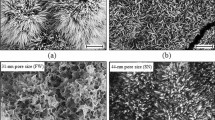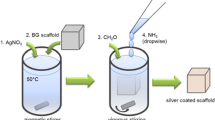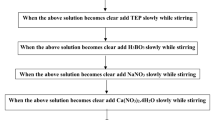Abstract
We analyzed the biological performance of spinodally and droplet-type phase-separated 45S5 Bioglass® generated by quenching the melt from different equilibrium temperatures. MC3T3-E1 pre-osteoblast cells attached more efficiently to 45S5 Bioglass® with spinodal than to the one with droplet morphology, providing the first demonstration of the role of micro-/nano-scale on the bioactivity of Bioglass®. Upon exposure to biological solutions, phosphate buffered saline (PBS) and cell culture medium (α-MEM), a layer of hydroxyapatite (HA) formed on both glass morphologies. Although both Bioglass® varieties were incubated under identical conditions, and physico-chemical characteristics of the HA layers were similar, the adsorption magnitude of a model protein, bovine serum albumin (BSA, an abundant blood serum component) and its β-sheet/β-turn ratio and α-helix content were significantly higher on spinodal than droplet type Bioglass®. These results indicate that: (i) a protein layer quickly adsorbs on the surface of 45S5 Bioglass® varieties (with or without HA layer), (ii) the amount and the conformation of adsorbed proteins are guided by the glass micro-/nano-structure, and (iii) cell attachment and proliferation are influenced by the concentration and the conformation of attached proteins with a significantly better cell adhesion to spinodal type 45S5 Bioglass® substrate. Taken together, our results indicate that the biological performance of 45S5 Bioglass® can be improved further with a relatively simple, inexpensive fabrication procedure that provides a superior glass micro-/nano-structure.
Graphical abstract
A simple modification to the fabrication procedure of classic 45S5 Bioglass® generates spinodal (A(a)) and droplet (A(b)) varieties and has a significant impact on protein adsorption (B) and cell adhesion (C). 







Similar content being viewed by others
References
Hench LL. The story of Bioglass. J Mater Sci Mater Med. 2006;17(11):967–78.
Filgueiras MR, La Torre G, Hench LL, Solution effects on the surface reactions of a bioactive glass. J Biomed Mater Res. 1993;27(4):445–53.
Filgueiras MR, LaTorre G, Hench LL, Solution effects on the surface reactions of three bioactive glass compositions. J Biomed Mater Res. 1993;27(12):1485–93.
Williams DF. Biocompatibility of orthopedic implants: CRC Press. Lc; 1982.
Hench LL, Jones JR, Fenn MB. New materials and technologies for healthcare. Imperial College Press, London; 2012.
Baino F, Vitale-Brovarone C. Three-dimensional glass-derived scaffolds for bone tissue engineering: current trends and forecasts for the future. J Biomed Mater Res A. 2011;97(4):514–35.
Bellucci D, Cannillo V, Sola A, Chiellini F, Gazzarri M, Migone C. Macroporous Bioglass®-derived scaffolds for bone tissue regeneration. Ceram Int. 2011;37(5):1575–85.
Boccaccini AR, Chen Q, Lefebvre L, Gremillard L, Chevalier J. Sintering, crystallisation and biodegradation behaviour of Bioglass-derived glass-ceramics. Faraday Discuss. 2007;136:27–44 discussion 107–23.
Gross U, Kinne R, Schmitz H, Strunz V. Critical reviews in Biocompatibility. Boca Raton, FL: CRC Press; 1988. p. 155.
Thomas MV, Puleo DA, Al-Sabbagh M. Bioactive glass three decades on. J Long Term Eff Med Implants. 2005;15(6):585–97.
Zhang D, Jain H, Hupa M, Hupa L. In‐vitro degradation and bioactivity of tailored amorphous multi porous scaffold structure. J Am Ceram Soc. 2012;95(9):2687–94.
Wang S, Kowal TJ, Marei MK, Falk MM, Jain H. Nanoporosity significantly enhances the biological performance of engineered glass tissue scaffolds. Tissue Eng Part A. 2013;19(13–14):1632–40.
Wang S, Falk MM, Rashad A, Saad MM, Marques AC, Almeida RM, et al. Evaluation of 3D nano–macro porous bioactive glass scaffold for hard tissue engineering. J Mater Sci: Mater Med. 2011;22(5):1195–203.
Vueva Y, Gama A, Teixeira AV, Almeida RM, Wang S, Falk MM, et al. Monolithic glass scaffolds with dual porosity prepared by polymer‐induced phase separation and sol–gel. J Am Ceram Soc. 2010;93(7):1945–9.
Marques AC, Almeida RM, Thiema A, Wang S, Falk MM, Jain H. Sol-gel-derived glass scaffold with high pore interconnectivity and enhanced bioactivity. J Mater Res. 2009;24(12):3495–502.
Lord MS, Foss M, Besenbacher F. Influence of nanoscale surface topography on protein adsorption and cellular response. Nano Today. 2010;5:66–78.
Roach P, Farrar D, Perry CC. Surface tailoring for controlled protein adsorption: effect of topography at the nanometer scale and chemistry. J Am Chem Soc. 2006;128(12):3939–45.
Elbe JA. Integrin-ligand interaction. Springer Science & Business Media, Dordrecht; 2013.
Nermut MV, Green NM, Eason P, Yamada SS, Yamada KM. Electron microscopy and structural model of human fibronectin receptor. EMBO J. 1988;7(13):4093–9.
Ye F, Hu G, Taylor D, Ratnikov B, Bobkov AA, McLean MA. et al. Recreation of the terminal events in physiological integrin activation. J Cell Biol. 2010;188(1):157–73.
Golovchak R, Thapar P, Ingram A, Savytskii D, Jain H. Influence of phase separation on the devitrification of 45S5 bioglass. Acta Biomater. 2014;10(11):4878–86.
Hench LL. Bioceramics: from concept to clinic. J Am Ceram Soc. 1991;74(7):1487–510.
Almeida RM, Hickey R, Jain H, Pantano CG. Low-energy ion scattering spectroscopy of silicate glass surfaces. J Non-Crystalline Solids. 2014;385:124–8.
Quarles LD, Yohay DA, Lever LW, Caton R, Wenstrup RJ. Distinct proliferative and differentiated stages of murine MC3T3-E1 cells in culture: an in vitro model of osteoblast development. J Bone Miner Res. 1992;7(6):683–92.
Wang D, Christensen K, Chawla K, Xiao G, Krebsbach PH, Franceschi RT. Isolation and characterization of MC3T3-E1 preosteoblast subclones with distinct in vitro and in vivo differentiation/mineralization potential. J Bone Miner Res. 1999;14(6):893–903.
Sepulveda P, Jones JR, Hench LL. In vitro dissolution of melt‐derived 45S5 and sol‐gel derived 58S bioactive glasses. J Biomed Mater Res. 2002;61(2):301–11.
Xynos ID, Edgar AJ, Buttery LD, Hench LL, Polak JM. Gene-expression profiling of human osteoblasts following treatment with the ionic products of Bioglass 45S5 dissolution. J Biomed Mater Res. 2001;55(2):151–7.
Tsigkou O, Jones JR, Polak JM, Stevens MM. Differentiation of fetal osteoblasts and formation of mineralized bone nodules by 45S5 Bioglass conditioned medium in the absence of osteogenic supplements. Biomaterials. 2009;30(21):3542–50.
Bohner M, Lemaitre J. Can bioactivity be tested in vitro with SBF solution?. Biomaterials. 2009;30(12):2175–9.
Price PJ, Gregory EA. Relationship between in vitro growth promotion and biophysical and biochemical properties of the serum supplement. In Vitro. 1982;18(6):576–84.
Byler DM, Susi H. Examination of the secondary structure of proteins by deconvolved FTIR spectra. Biopolymers. 1986;25(3):469–87.
Gruian C, Vanea E, Simon S, Simon V. FTIR and XPS studies of protein adsorption onto functionalized bioactive glass. Biochim Biophys Acta. 2012;1824(7):873–81.
Surewicz WK, Mantsch HH. New insight into protein secondary structure from resolution-enhanced infrared spectra. Biochim Biophys Acta. 1988;952(2):115–30.
Tunc S, Maitz MF, Steiner G, Vazquez L, Pham MT, Salzer R. In situ conformational analysis of fibrinogen adsorbed on Si surfaces. Colloids Surf B Biointerfaces. 2005;42(3–4):219–25.
Vanea E, Magyari K, Simon V. Protein attachment on aluminosilicates surface studied by XPS and FTIR spectroscopy. J Optoelectron Adv Mater. 2010;12(5):1206–12.
Molino PJ, Higgins MJ, Innis PC, Kapsa RM, Wallace GG. Fibronectin and bovine serum albumin adsorption and conformational dynamics on inherently conducting polymers: a QCM-D study. Langmuir. 2012;28(22):8433–45.
Renny M, Baltzar S, Mattias E. Na/Ca intermixing around silicate and phosphate groups in bioactive phosphosilicate glasses revealed by heteronuclear solid-state NMR and molecular dynamics simulations. J Phys Chem B. 2015;119(17):5701–15.
Renny M, Turdean-Ionescu C, Stevensson B, Izquierdo-Barba I, García A, Arcos D, et al. “Direct probing of the phosphate-ion distribution in bioactive silicate glasses by solid-state NMR: evidence for transitions between random/clustered scenarios. Chem Mater. 2013;25(9):1877–85.
Lefebvre L, Chevalier J, Gremillard L, Zenati R, Thollet G, Bernache-Assolant D, et al. Structural transformations of bioactive glass 45S5 with thermal treatments. Acta Mater. 2007;55(10):3305–13.
O’Donnell MD, Watts SJ, Law RV, Hill RG. Effect of P 2 O 5 content in two series of soda lime phosphosilicate glasses on structure and properties–Part I: NMR. J Non-Cryst Solids. 2008;354(30):3554–60.
Pedone A, Charpentier T, Malavasi G, Menziani MC. New insights into the atomic structure of 45S5 bioglass by means of solid-state NMR spectroscopy and accurate first-principles simulations. Chem Mater. 2010;22(19):5644–52.
Ceccarini C, Eagle H. pH as a determinant of cellular growth and contact inhibition. Proc Natl Acad Sci. 1971;68(1):229–33.
Eagle H. The effect of environmental pH on the growth of normal and malignant cells. J Cell Physiol. 1973;82(1):1–8.
Jain RH, Wang S, Moawad H, Falk MM, Jain H. Glass bone implants: the effect of surface topology on attachment and proliferation of osteoblast cells on 45S bioactive glass. In: Bhatia S, Bryant S, Burdick JA, Karp JM, Walline K, editors. Engineering biomaterials for regenerative medicine. Mater. Res. Soc. Symp. Proc. Vol. 1235, Warrendale, PA, 2010. 1235-RR03-47.
Bahniuk MS, Pirayesh H, Singh HD, Nychka JA, Unsworth LD, Bioactive glass 45S5 powders: effect of synthesis route and resultant surface chemistry and crystallinity on protein adsorption from human plasma. Biointerphases. 2012;7(1–4):41.
Effah Kaufmann EAB, Ducheyne P, Radin S, Bonnell DA, Composto R. Initial events at the bioactive glass surface in contact with protein-containing solutions. J Biomed Mater Res A. 2000;52(4):825–30.
El-Ghannam A, Ducheyne P, Shapiro IM. Effect of serum proteins on osteoblast adhesion to surface-modified bioactive glass and hydroxyapatite. J Orthop Res. 1999;17(3):340–5.
Magyari K, Gruian C, Varga B, Ciceo-Lucacel R, Radu T, Steinhoff HJ, et al. Addressing the optimal silver content in bioactive glass systems in terms of BSA adsorption. J Mater Chem B. 2014;2(35):5799–808.
Wang K, Zhou C, Hong Y, Zhang X. A review of protein adsorption on bioceramics. Interface Focus. 2012;2(3):259–77.
Wilson CJ, Clegg RE, Leavesley DI, Pearcy MJ. Mediation of biomaterial-cell interactions by adsorbed proteins: a review. Tissue Eng. 2005;11(1–2):1–18.
Peters T, editor. The Plasma Proteins. Putman, FW ed: Academic Press, New York; 1975.
Wright AK, Thompson MR. Hydrodynamic structure of bovine serum albumin determined by transient electric birefringence. Biophys J. 1975;15(2 Pt 1):137–41.
Nilausen K. Role of fatty acids in growth-promoting effect of serum albumin on hamster cells in vitro. J Cell Physiol. 1978;96(1):1–14.
Huang BX, Kim HY, Dass C. Probing three-dimensional structure of bovine serum albumin by chemical cross-linking and mass spectrometry. J Am Soc Mass Spectrom. 2004;15(8):1237–47.
Vlasova I, Saletsky A. Raman spectroscopy in investigations of secondary structure of human serum albumin at binding of nanomarkers of fluorescein family. Laser Phys. 2010;20(9):1844–8.
Wen Z, Hecht L, Barron L. alpha-Helix and associated loop signatures in vibrational Raman optical activity spectra of proteins. J Am Chem Soc. 1994;116(2):443–5.
Slack SM, Horbett TA. The Vroman effect-A critical review. Proteins Interfaces II. 1995;602:112–28.
Roach P, Farrar D, Perry CC. Interpretation of protein adsorption: surface-induced conformational changes. J Am Chem Soc. 2005;127(22):8168–73.
Tiselius A, Hjerten S, Levin Ö. Protein chromatography on calcium phosphate columns. Arch Biochem Biophys. 1956;65(1):132–55.
Bernardi G, Giro M-G, Gaillard C. Chromatography of polypeptides and proteins on hydroxyapatite columns: some new developments. Biochim Biophys Acta (BBA)-Protein Struct. 1972;278(3):409–20.
Gorbunoff MJ, Timasheff SN. The interaction of proteins with hydroxyapatite: III. Mechanism. Anal Biochem. 1984;136(2):440–5.
Luo Q, Andrade JD. Cooperative adsorption of proteins onto hydroxyapatite. J Colloid Interface Sci. 1998;200(1):104–13.
Garcia AJ, Ducheyne P, Boettiger D. Effect of surface reaction stage on fibronectin-mediated adhesion of osteoblast-like cells to bioactive glass. J Biomed Mater Res. 1998;40(1):48–56.
Moawad H, Jain H, editors. Fabrication of nano–macro porous soda-lime phosphosilicate bioactive glass by the melt-quench method. Ceramic engineering and science proceeding; 2007.
Acknowledgements
The authors would like to thank Bill Mushock of Lehigh University’s microscopy facility for his help with the FEI XL30 ESEM. We thank the National Science Foundation for supporting this work via International Materials Institute for New Functionality in Glass (IMI-NFG, DMR-0844014) and PFI:AIR-TT (IIP-1602057) programs. The work in the laboratory of MMF is supported by the National Institutes of Health (NIH-NIGMS, grant R01 GM55725) and an Innovators’ Circle grant from the Abington Health Foundation.
Author contributions
TJK performed experiments, evaluated data, wrote sections of the manuscript; generated figures, edited the manuscript; RG performed experiments, evaluated data, wrote sections of the manuscript, generated figures, edited the manuscript; TC performed experiments, evaluated data; JH performed Raman measurements, evaluated data; UT performed analytical experiments; HJ, designed experiments, supervised research, edited manuscript; MMF, designed experiments, supervised research, composed and edited figures and edited the manuscript.
Author information
Authors and Affiliations
Corresponding authors
Ethics declarations
Conflict of interest
The authors declare that they have no competing interests.
Additional information
Tia J. Kowal and Roman Golovchak contributed equally to this work.
Himanshu Jain and Matthias M. Falk jointly supervised to this work.
Electronic supplementary material
Rights and permissions
About this article
Cite this article
Kowal, T.J., Golovchak, R., Chokshi, T. et al. Role of phase separation on the biological performance of 45S5 Bioglass® . J Mater Sci: Mater Med 28, 161 (2017). https://doi.org/10.1007/s10856-017-5976-6
Received:
Accepted:
Published:
DOI: https://doi.org/10.1007/s10856-017-5976-6




